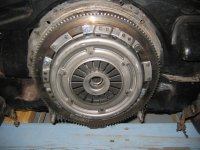- Joined
- Aug 8, 2022
- Messages
- 1,218
I crossed paths with someone near me who, for reasons unknown, likes to collect, store, and resell old VW bugs and other VW vehicles. Don't know why, he just likes to. But when he found out that I have a pipe dream of converting an old VW to electric, he basically offered me to come pick one out (not for free, that'd be too good. But for cheap enough that my pipe dream might not be a pipe dream). Even has a couple with the IC motors already removed.
Therefore I'm actually looking at the specifics of how to go about this. There's decent info out there for converting these. Just thinking for now. But I wanted to gather opinions on one specific item that the internet isn't solid on.
The Bug's motor mates with the transaxle, which has a splined shaft. The clutch plate and flywheel fit over the splined transmission shaft
Google images, transmission input:

Clutch/flywheel assembly:

My question is this. If I can locate a motor of a suitable power, and mount it in the engine bay. Can I do it with simply a coupler from the new electric motor shaft to the input shaft of the transaxle? Or do I need to preserve the flywheel/clutch from the original motor?
If you google VW bug electric conversions, 75% of the results use the Hyper9 motor with a shaft-to-shaft. So in theory I don't really need the flywheel setup, which is just there to smooth the IC engine's output.
I realize that there's a ton of variables. Just wondering what obvious things I'm missing regarding clutch vs no clutch. Thanks for looking!
(Here's a link to the expensive EVWest bolt-on kit, where it seems like it's just a shaft-to-shaft connection)
Therefore I'm actually looking at the specifics of how to go about this. There's decent info out there for converting these. Just thinking for now. But I wanted to gather opinions on one specific item that the internet isn't solid on.
The Bug's motor mates with the transaxle, which has a splined shaft. The clutch plate and flywheel fit over the splined transmission shaft
Google images, transmission input:

Clutch/flywheel assembly:

My question is this. If I can locate a motor of a suitable power, and mount it in the engine bay. Can I do it with simply a coupler from the new electric motor shaft to the input shaft of the transaxle? Or do I need to preserve the flywheel/clutch from the original motor?
If you google VW bug electric conversions, 75% of the results use the Hyper9 motor with a shaft-to-shaft. So in theory I don't really need the flywheel setup, which is just there to smooth the IC engine's output.
I realize that there's a ton of variables. Just wondering what obvious things I'm missing regarding clutch vs no clutch. Thanks for looking!
(Here's a link to the expensive EVWest bolt-on kit, where it seems like it's just a shaft-to-shaft connection)




